A hillock stands close to the city walls, and on it there is a sacred building that reflects the harmony of the cosmos. The temple of St. Michael the Archangel in Perugia is circular, as symbol of the perfection of all creation, but also image and anticipation of the heavenly Jerusalem. There is an eschatological meaning in the symbolism, in the repetition of forms and in the elegant symmetries: the building embodies the fundamental principles of the universe, it is a true Christian temple. The circle, the square and the cross are the architectural prerequisites for elevating space to the dimension of the sacred, for leading the earthly pilgrim Church towards heaven.
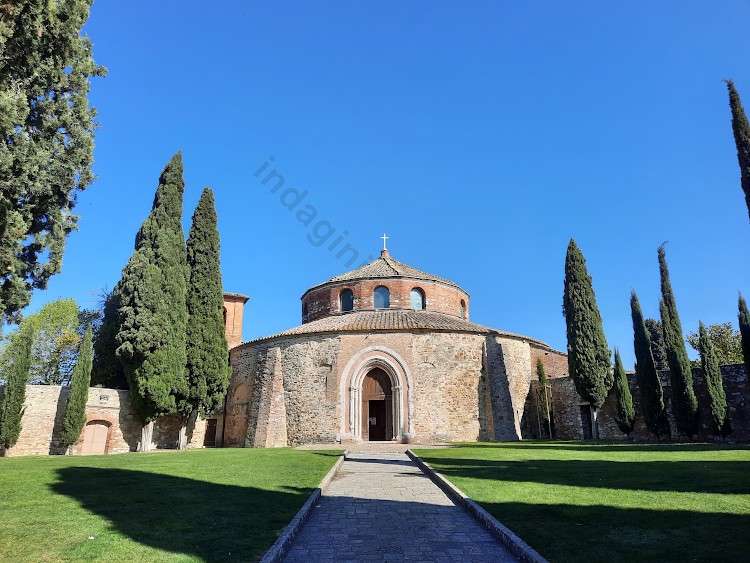
Architecture and symbolism
The origins of the temple of St. Michael, near Borgo di Sant’Angelo in Perugia, are around the 6th-7th centuries, although it is unclear whether it is attributable to Byzantine1 or Longobard2 masters. Nevertheless, the building was constructed on the basis of a pre-existing early Christian structure, which had incorporated many reused Roman elements, and not pagan as the local tradition claim3.
The plan of the temple of St. Michael the Archangel in Perugia
The architecture of the early Medieval church had a central Greek-cross plan with four radial chapels oriented in the direction of the cardinal points. Although these rooms were partially lost – only two are preserved today – their original spatial arrangement is still perceptible. They were accessed from inside the church, through wide openings with three arches, known as triforia, or directly from outside. An exception was the eastern space, the only one not rectangular. One of the entrances, located to the south, corresponds today to the Gothic marble portal, built in the 14th century. It is reasonable that the chapels accessible from outside served as women’s galleries4, keeping men and women separate during the liturgy, while the presbytery was located to the east.
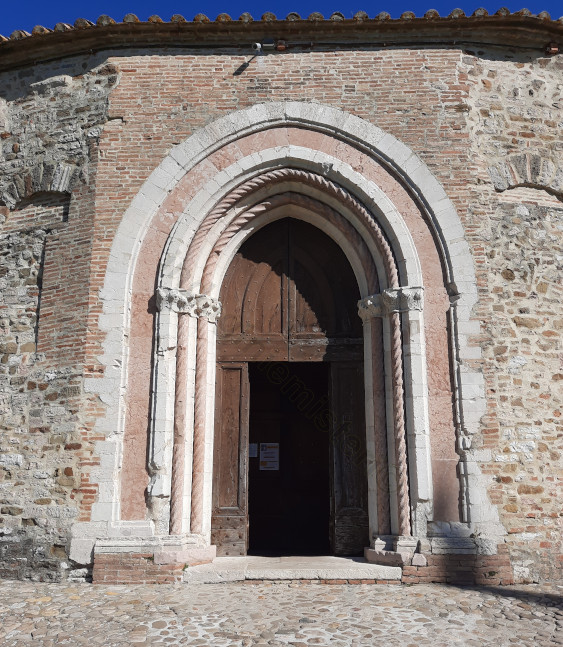
The peristyle
Unlike the radial chapels, the circular peristyle separating the inner chamber of the church from the ambulatory has been preserved intact. It consists of sixteen columns arranged in pairs5, as can be seen from the base supports and the upper arches. The pairs oriented towards the cardinal points (except west) in axis with the chapels are of grey granite, while the others are of polychrome marble. This geometric arrangement echoes the symbolism of the number eight, an image of Christ’s never-ending time; after God created the world in seven days, the eighth came, the day of eternal life.
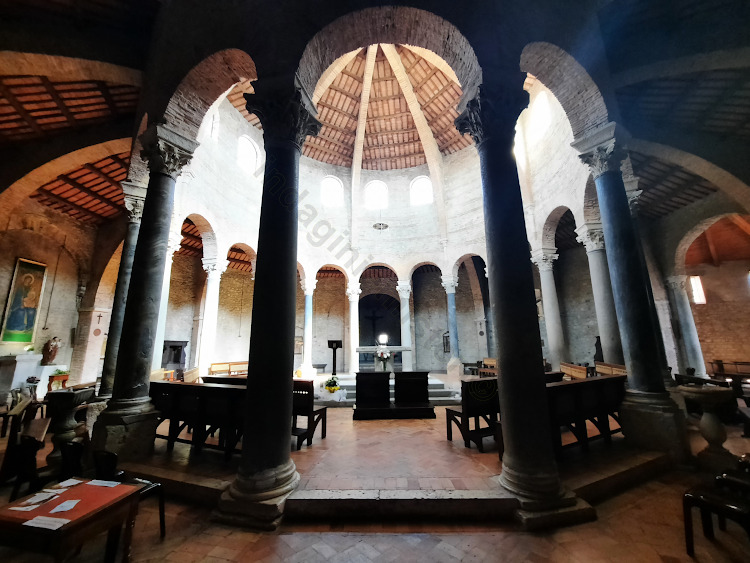
The columns are certainly reused; they could date back to the 2nd century6. In the north and south pairs, the Corinthian capitals feature the engraving of eight epigraphs in Greek letters. The resulting grooves were then repainted with black color. These engravings are a mystery because their meaning has never been clarified. Seven of the epigraphs contain three letters, while only one capital is engraved with the letter eta (H). Several theories have been suggested to explain the Greek engravings in the temple of Sant’Angelo. Are they the names of the stonemasons who made the capitals7? Or perhaps they belonged to an ancient burial8?
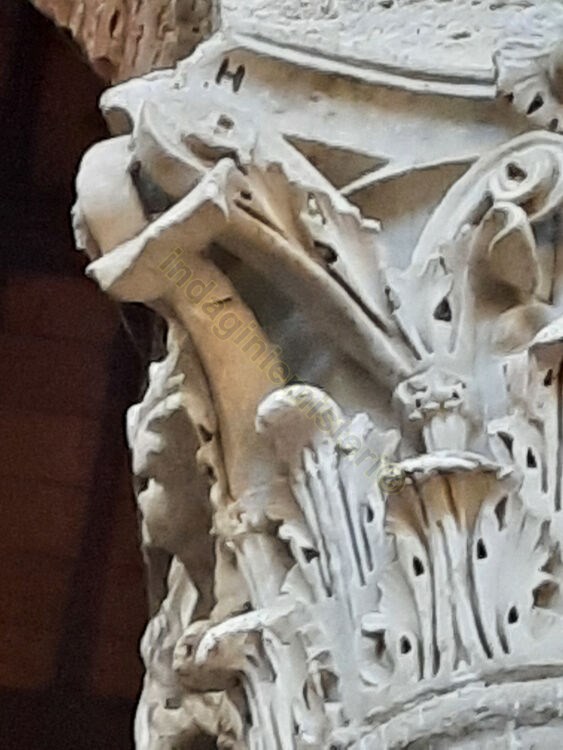
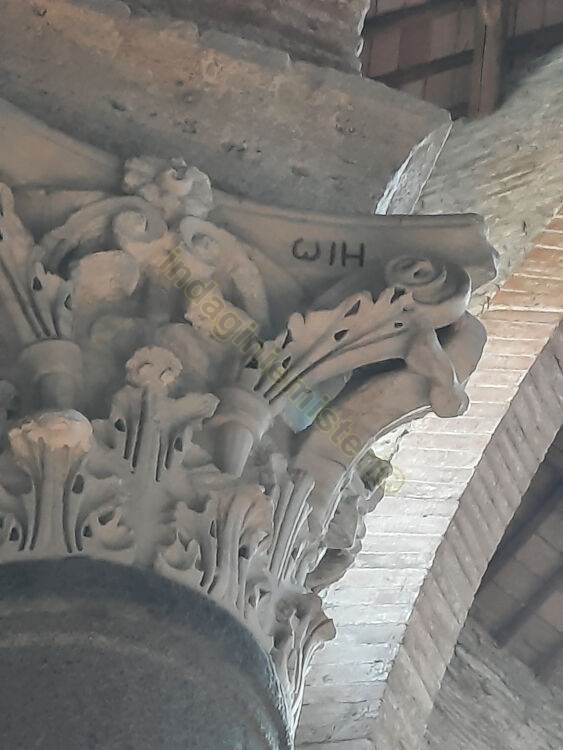
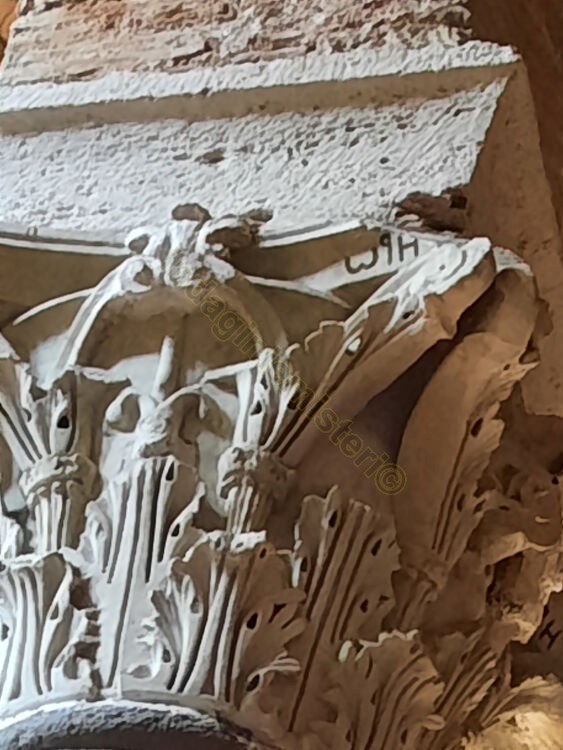
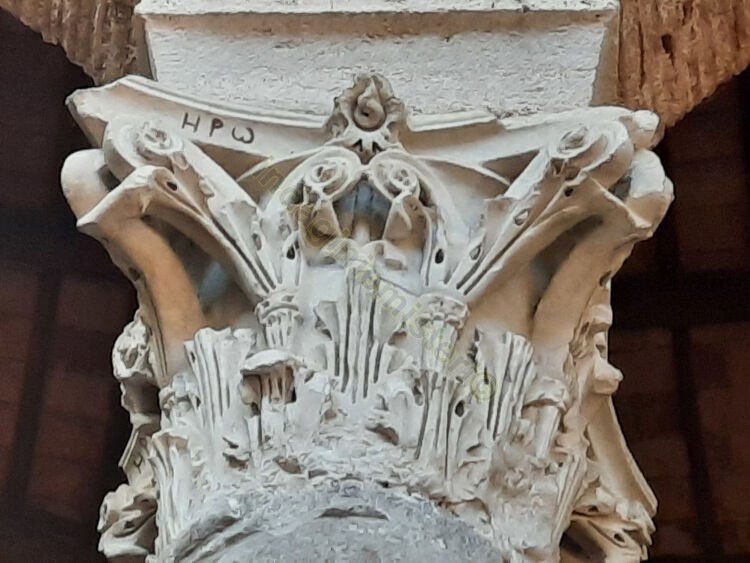
A reasonable hypothesis is that the engravings are Christograms with an eschatological meaning, written in Greek characters in the 7th century9.
The symbolism of light
The columns of the peristyle, with Corinthian capitals and pulvinos, are connected by round arches. They support the central drum which, rising above the level of the ambulatory, houses twelve monofora windows. As there is no rose window, these are the only source of light, which penetrates the building evenly and softly, from top to bottom.
This causes the central space, where the altar is located, to be enveloped by the rays of the sun, while everything else remains in shadow. The light, image of the Trinity, illuminates the darkness of the world through the Eucharistic sacrifice. Thus the bare table, consisting of the stone of a Roman tomb and a section of column, symbolically transfigures from death to resurrection. The arrangement of the monofora windows, oriented according to the four cardinal points in correspondence with the underlying triforia, reflects a precise symbolic choice. The number twelve in Christian exegesis is associated with the totality of things: twelve are the tribes of Israel, twelve the apostles, but above all twelve are the gates of the heavenly Jerusalem.
There is therefore an eschatological message in the two circular and overlapping structures of the temple of St. Michael the Archangel in Perugia; it tends prospectively upwards, prepares for a metaphysical ascension of the soul. The terracotta floor mimics the condition of death and darkness. On the floor, in fact, we see numerous tombstones with the coats of arms of Perugia’s artisan guilds. However, on raising our gaze we realise that the ceiling converges upwards, symbolically raising the spirit in the direction of the drum and its twelve monofora windows. Light penetrates there, powerfully creating the lightening of the shadows, metaphor of the resurrection.
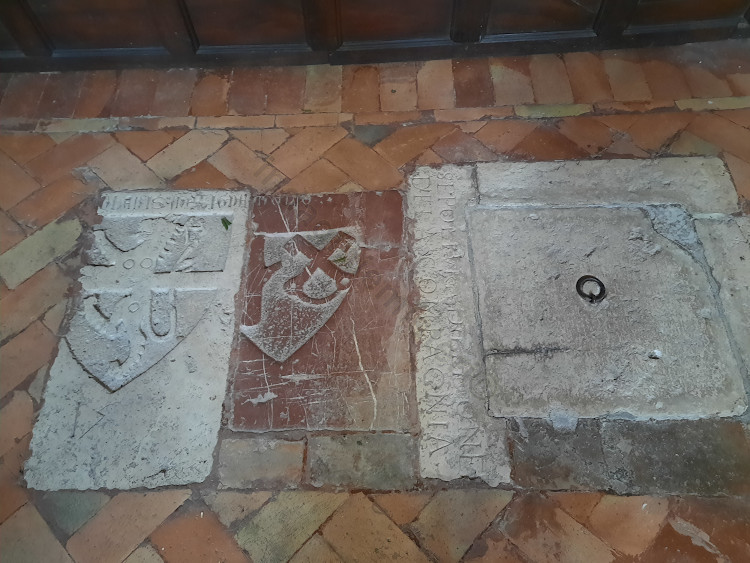
A cosmic temple
The architectural choices that characterise the building of St. Michael the Archangel reflect the archetype of a cosmic temple. It encapsulates the image of creation, summarises the structural and fundamental principles of the universe: the church was built according to precise geometric criteria corresponding to them.
The circle
The figure of the circle, which is repeated in the elevation at the level of the central body and the tiburium, represents the perfection of creation in its totality. At the time, it was believed that the universe was a great sphere at the centre of which was the earth10 and thus man, a creature in the image and likeness of God. At the structural centre of the temple of St. Michael is the Eucharistic table: it is here that the salvific plan for humanity is realised through the sacrifice of Christ.
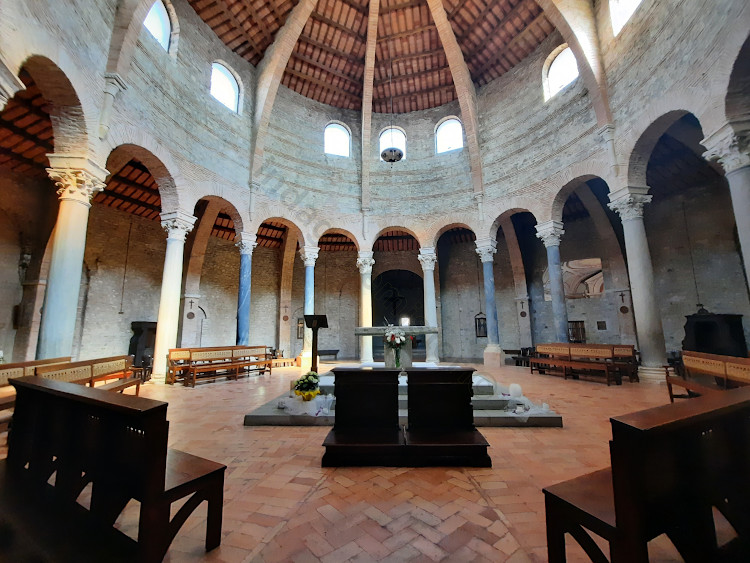
The cross
Liturgy and architecture are therefore an inseparable whole, forming a functional and symbolic relationship that elevates the spirit to the dimension of the sacred. The church in Perugia is templum of the mystical body of Christ, whose foundation is represented by the cross in an architectural sense – the radial chapels originally formed a Greek cross in plan – and equally metaphorical. Just as the heavenly Jerusalem houses the assembly of saints in the presence of God, so the church in Perugia, of that prophetic reflection, houses the ecclesia on earth. Christ’s saving work is for all of humanity, and this totality is constantly recalled in the building’s constituent elements: the symbolism of the eight in the columns near the peristyle, and the recurrence of the number twelve in the monofora windows. It is John, in the Book of Revelation, who defines the sacred archetype that inspired its builders:
He took me in spirit to a great, high mountain and showed me the holy city Jerusalem coming down out of heaven from God. It gleamed with the splendor of God. Its radiance was like that of a precious stone, like jasper, clear as crystal. It had a massive, high wall, with twelve gates where twelve angels were stationed and on which names were inscribed, (the names) of the twelve tribes of the Israelites. There were three gates facing east, three north, three south, and three west. The wall of the city had twelve courses of stones as its foundation, on which were inscribed the twelve names of the twelve apostles of the Lamb.
Book of Revelation 21, 10-14
The square
The Perugian church is oriented according to the four cardinal points, another universal principle by which, in the Middle Ages, master builders defined the architecture of the Christian temple. Hence, the square established the harmonic arrangement of matter in space. Four are the cardinal points, the seasons and likewise the elements that constitute the sensible world: water, fire, earth, air.
It is through them that the liturgy proceeds, since they are tangible signs of creation and thus intimately constitutive of the cosmic temple. Water is the source from which life originates, and thus the rebirth of the christian in baptism; fire is the light that illuminates the darkness, as in the Easter candle represents the Eucharist and Christ’s resurrection; earth is a penitential symbol: “you are dust, and to dust you shall return.”11; God had in fact created man from the “dust of the ground”, then “breathed into his nostrils the breath of life” (ruah), and the man became a living being12.
The temple of St. Michael the Archangel in Perugia between microcosm and macrocosm
Several decades later, during the Renaissance, this analogy between the church-temple and creation could be expressed in terms of the relationship between microcosm and macrocosm. The Perugian building was thus a part of the whole, but at the same time summarised the principles of the universe. In the hermetic sphere, this was expressed through the symbol of the pentacle13: to the four natural elements, constitutive of the cosmos, was added the spiritual one. Now, it is not possible to ascertain whether this is a coincidence, but in the Temple of Sant’Angelo, not far from the entrance, a pentacle engraved on a floor slab is displayed in plain sight.
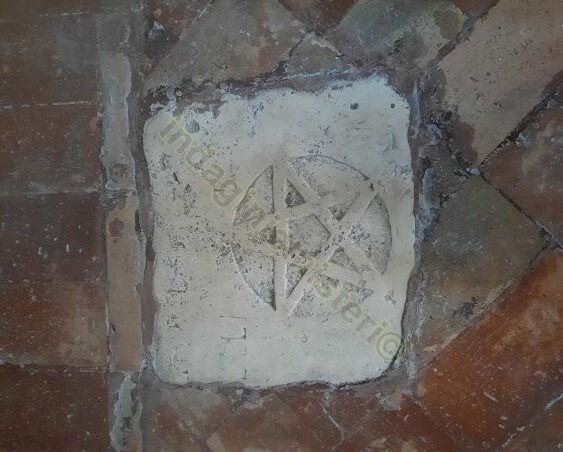
Dedication to St. Michael the Archangel
At the time of its foundation, the Temple of St. Michael the Archangel was located outside the city walls of Perugia, in a position dominating it. It functioned, therefore, as an elevated sacred space, a privileged place of encounter with the divine in which an intercession between earth and heaven was realised.
This role was entrusted to the Archangel Michael and it is easy to understand why. Michael is primarily the commander of the angelic militia (ἀϱχάγγελοϚ), he is prince of the heavenly Jerusalem14. He is the guarantor of cosmic order, and as such is the one who suppresses Lucifer’s rebellion and confines him to the hells, outside the divine creation. The Archangel thus represents the archetype of the righteous warrior who fights according to the supreme will of God. In the 7th century, he was invoked by both the Byzantines and the Longobards, by the latter in particular as defender of the Regnum Langobardorum. Michael, with his temple, stood close to the walls so that he could protect the people of Perugia and be invoked when needed.

The temple of St. Michael the Archangel in Perugia and the Knights Templar
The church of St. Michael the Archangel in Perugia reveals the influence of oriental and Byzantine craftsmen; there are numerous stylistic elements that connect it with the Basilica of San Vitale in Ravenna, or the anastasis of the Bologna complex of Santo Stefano. It is probable that the builders of the church intended to imitate the architecture of the Holy Sepulchre in Jerusalem.
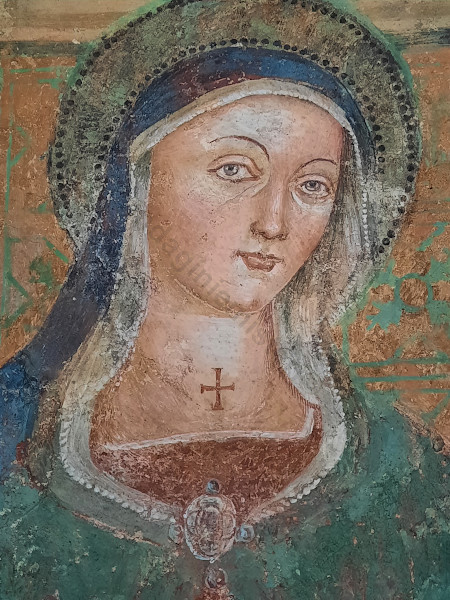
When the Templars settled in Perugia – their presence is well attested at the church of San Bevignate – they certainly could not remain indifferent to that architecture. The Temple of Sant’Angelo evoked the sacred sites of Jerusalem, whose custody was entrusted to chivalric Order of Hugues de Payns. We find traces of the Templars’ passage in a few secondary elements, faint but revealing clues, uncertain heritages that persist in the memory of posterity even after the dissolution of the Order (1312-1314), such as a red Cross Pattée on a 15th-century fresco of the Madonna delle Grazie.
Samuele Corrente Naso
Map of places
Notes
- D. Scortecci, Riflessioni sulla cronologia del tempio perugino di San Michele Arcangelo, in RACrist, LXVII, 1991. ↩︎
- P. Castellani, Un’ipotesi di lettura longobarda per la chiesa di S. Michele Arcangelo a Perugia, Arte medievale 10 (1), 1996.. ↩︎
- D. Viviani, Tempio di S. Angelo in Perugia. Studio di ripristino, Bollettino della Deputazione di storia patria per l’Umbria XVI, 1911. ↩︎
- Ibidem. ↩︎
- P. Belardi, La chiesa di S. Michele Arcangelo a Perugia, in Rotonde d’Italia. Analisi tipologica della pianta centrale, a cura di V. Volta, Milano, Jaca Book, 2008. ↩︎
- L. Cenciaioli, I capitelli romani di Perugia, Annali della Facoltà di Lettere e Filosofia dell’Università di Perugia, 1977/78. ↩︎
- B. Orsini, Dissertazione sull’antico Tempio di Sant’Angelo, 1792. ↩︎
- G. B. Vermiglioli, Antiche iscrizioni perugine. Raccolte dichiarate e pubblicate, volume secondo, Perugia, Tipografia Baduel, 1834. ↩︎
- A. Bazzoli, Vera deum facies. A proposito delle iscrizioni greche del Tempio di Sant’Angelo in Perugia, Bollettino della Deputazione di storia patria per l’Umbria, 2012. ↩︎
- E. Grant, La scienza bizantina e latina: la nascita di una scienza europea. La cosmologia. In Enciclopedia Treccani – Storia della Scienza, 2001. ↩︎
- Book of Genesis 3, 19. ↩︎
- Book of Genesis 2, 7. ↩︎
- Heinrich Cornelius Agrippa, Three Books of Occult Philosophy, Book 3, 1533. ↩︎
- Epistle of Jude 9. ↩︎

